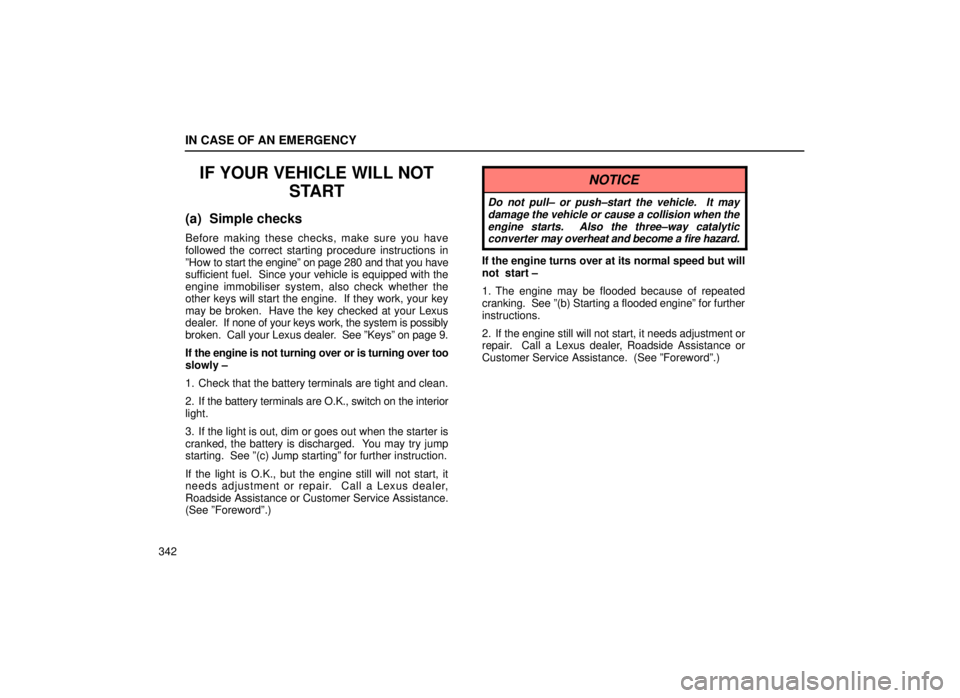Page 352 of 495

DRIVING TIPS
336
HOW TO SAVE FUEL AND
MAKE YOUR VEHICLE LAST LONGER
Getting more kilometer/mileage from a liter/gallon of fuel
is easy ± just take it easy. It will help make your vehicle
last longer, too. Here are some specific tips on how to
save money on both fuel and repairs:
� Keep your tires inflated at the correct pressure.
Check the pressure every two weeks, or at least once
a month. Underinflation causes tire wear and wastes
fuel.
� Do not carry unneeded weight in your vehicle.
Excess weight puts a heavier load on the engine,
causing greater fuel consumption.
� Avoid lengthy warm±up idling. Once the engine is
running smoothly, begin driving ± but gently.
Remember, however, that on cold winter days this
may take a little longer.
� Accelerate slowly and smoothly. Avoid jackrabbit
starts.
� Avoid long engine idling. If you have a long wait
and you are not in traffic, it is better to turn off the
engine and start again later.
� Avoid engine overrevving. Use a gear position
suitable for the road on which you are traveling. �
Avoid continuous speeding up and slowing
down. Stop±and±go driving wastes fuel.
Page 353 of 495

DRIVING TIPS
337
�
Avoid unnecessary stopping and braking.
Maintain a steady pace. Try to time the traffic si gnals
so you only need to stop as little as possible or take
advantage of through streets to avoid traffic lights.
Keep a proper distance from other vehicles to avoid
sudden braking. This will also reduce wear on your
brakes.
� Avoid heavy traffic or traffic jams whenever
possible.
� Do not rest your foot on the brake pedal. This
causes needless wear, overheating and poor fuel
economy.
� Maintain a moderate speed on highways. The
faster you drive, the greater the fuel consumption. By
reducing your speed, you will cut down on fuel
consumption.
� Keep the front wheels in proper alignment. Avoid
hitting the curb and slow down on rough roads.
Improper alignment not only causes faster tire wear
but also puts an extra load on the engine, which, in
turn, wastes fuel.
� Keep the bottom of your vehicle free from mud,
etc. This not only lessens weight but also helps
prevent corrosion.
� Keep your vehicle tuned±up and in top shape. A
dirty air cleaner, improper valve clearance, dirty
plugs, dirty oil and grease, brakes not adjusted, etc.
all lower engine performance and contribute to poor
Page 354 of 495
DRIVING TIPS
338fuel economy. For longer life of all parts and lower
operating costs, keep all maintenance work on
schedule, and if you often drive under severe
conditions, see that your vehicle receives more
frequent maintenance. (For scheduled maintenance
information, please refer to the separate ºOwner's
Manual Supplement/Maintenance Scheduleº.)
CAUTION
Never turn off the engine to coast down hills. Your
power steering and brake booster will not function
without the engine running. Also, the emission control
system operates properly only when the engine is
running.
Page 358 of 495

IN CASE OF AN EMERGENCY
342
IF YOUR VEHICLE WILL NOTSTART
(a) Simple checks
Before making these checks, make sure you have
followed the correct starting procedure instructions in
ºHow to start the engineº on page 280 and that you have
sufficient fuel. Since your vehicle is equipped with the
engine immobiliser system, also check whether the
other keys will start the engine. If they work, your key
may be broken. Have the key checked at your Lexus
dealer. If none of your keys work, the system is possibly
broken. Call your Lexus dealer. See ºKeysº on page 9.
If the engine is not turning over or is turning over too
slowly ±
1. Check that the battery terminals are tight and clean.
2. If the battery terminals are O.K., switch on the interior
light.
3. If the light is out, dim or goes out when the starter is
cranked, the battery is discharged. You may try jump
starting. See º(c) Jump startingº for further instruction.
If the light is O.K., but the engine still will not start, it
needs adjustment or repair. Call a Lexus dealer,
Roadside Assistance or Customer Service Assistance.
(See ºForewordº.)
NOTICE
Do not pull± or push±start the vehicle. It may damage the vehicle or cause a collision when theengine starts. Also the three±way catalyticconverter may overheat and become a fire hazard.
If the engine turns over at its normal speed but will
not start ±
1. The engine may be flooded because of repeated
cranking. See º(b) Starting a flooded engineº for further
instructions.
2. If the engine still will not start, it needs adjustment or
repair. Call a Lexus dealer, Roadside Assistance or
Customer Service Assistance. (See ºForewordº.)
Page 397 of 495

MAINTENANCE
381
GENERAL MAINTENANCE
Listed below are the general maintenance items that
should be performed at the intervals specified. It is
recommended that any problem you notice be brought
to the attention of your Lexus dealer or qualified service
shop for their advice.
CAUTION
Make these checks only where adequate ventilation can
be obtained if you run the engine.
Vehicle exterior
Items listed below should be performed from time to
time, unless otherwise specified.
Tire pressure
Check the pressure with a gauge every two weeks, or at
least once a month and adjust as shown on the tire
pressure label. See page 421 for additional information.
Tire surface
Check the tires carefully for cuts, damage or excessive
wear. See page 425 for additional information.
Wheel nuts
When checking the tires, make sure to check the nuts for
looseness. Tighten them if necessary. Tire rotation
Rotate
the tires every 12000 km (7500 miles). See page
423 for additional information.
Fluid leaks
Check underneath for leaking fuel, oil, water or other
fluid after the vehicle has been parked for a while. If you
smell fuel fumes or notice any leak, have the cause
found and corrected immediately.
Doors and engine hood
Check that all doors, including trunk lid, operate
smoothly and all latches lock securely. Make sure the
engine hood secondary latch secures the hood when the
primary latch is released.
Page 399 of 495

MAINTENANCE
383
Parking brake
Check that the pedal has the proper travel and that, on
a safe incline, your vehicle is held securely with only the
parking brake applied.
Automatic transmission ºParkº mechanism
On a safe incline, check that your vehicle is held
securely with the selector lever in ºPº position and all
brakes released.
Engine compartment
Items listed below should be checked from time to
time, e.g. each time when refueling.
Washer fluid
Make sure there is sufficient fluid in the tank. See page
459 for additional information.
Engine coolant level
Make sure the coolant level is between the Upper and
Lower lines on the see±through reservoir when the
engine is cold. See page 409
for additional information.
Battery
Your Lexus has a maintenance free battery. You do not
have to add distilled water. For longer life of the battery,
however, see page 443 for additional information.
Brake fluid level
Make sure the brake fluid level is correct. See page 417
for additional information.
Page 407 of 495

INTRODUCTION
391
CAUTION
�When the engine is running, keep hands, clothing,
and tools away from the moving fan and engine drive
belt. (Removing rings, watches, and ties is
advisable.)
� Right after driving, the engine compartment ± the
engine, radiator, exhaust manifold and power
steering fluid reservoir, etc. ± will be hot. So be
careful not to touch them. Oil and other fluids may
also be hot.
� Do not smoke, cause sparks or allow open flames
around fuel or the battery. Their fumes are
flammable.
� Be extremely cautious when working on the battery.
It contains poisonous and corrosive sulfuric acid.
� Do not get under your vehicle with just the body jack
supporting it. Always use automotive jack stands or
other solid supports.
� Be sure the ignition is off if you work near the electric
cooling fan or radiator grille. With the ignition on, the
electric cooling fan may automatically start to run if
the air conditioning is on and/or if the coolant
temperature is high.
� Use eye protection whenever you work on or under
your vehicle where you may be exposed to flying or
falling material, fluid spray, etc.
Page 411 of 495
SECTION 6 ± 2
395
SERVICE PROCEDURES AND
SPECIFICATIONS
Engine
Specifications396
. . . . . . . . . . . . . . . . . . . . . . . . . . . . . . . .
Fuel 400
. . . . . . . . . . . . . . . . . . . . . . . . . . . . . . . . . . . . \
. . . . .
Facts about engine oil consumption 402
. . . . . . . . . . . . .
Used engine oil 404
. . . . . . . . . . . . . . . . . . . . . . . . . . . . . . .
Checking the engine oil level 405
. . . . . . . . . . . . . . . . . . .
Checking the engine coolant level 409
. . . . . . . . . . . . . . .
Spark plugs 413
. . . . . . . . . . . . . . . . . . . . . . . . . . . . . . . . . .